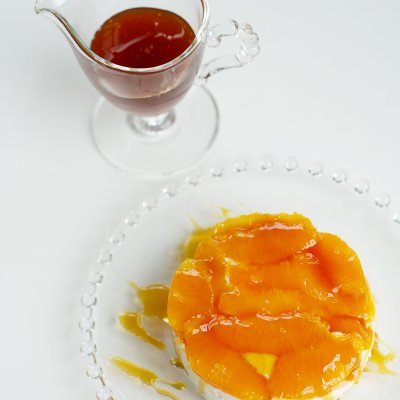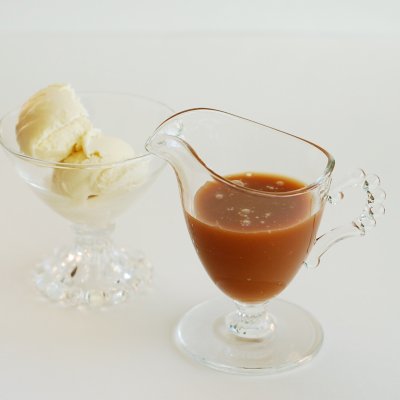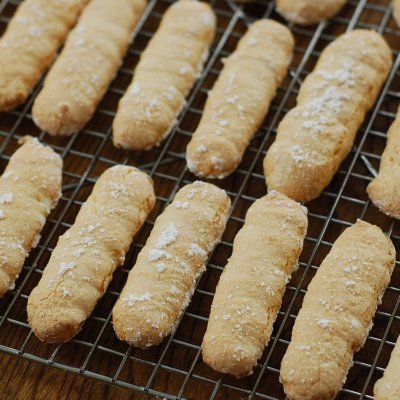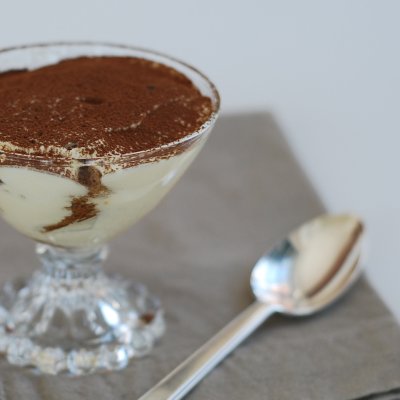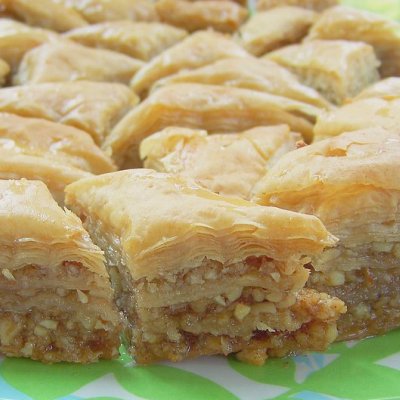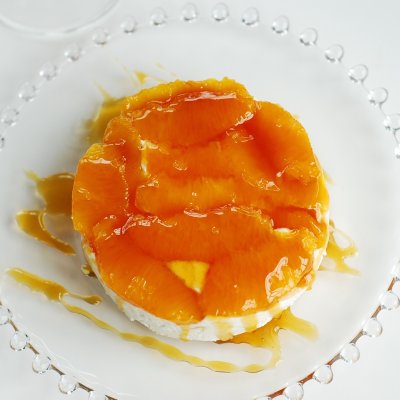
{The 2010 March Daring Baker's challenge was hosted by Jennifer of Chocolate Shavings. She chose Orange Tian as the challenge for this month, a dessert based on a recipe from Alain Ducasse's Cooking School in Paris.}
If I were to come across this recipe in a cookbook, I might not have chosen it as one of the first to try. Just the length of the recipe would probably discourage me from trying it! But I'm so glad that Jennifer picked it for all of the Daring Bakers to make this month. This is just one of the reasons I like the Daring Bakers. It takes me beyond the chocolate desserts and the lemony sweets I am drawn to and is expanding my horizons with every challenge.

This tian is a molded layered dessert comprised of 5 components (this seems to be a recurring theme as last month's tiramisu had multiple components as well.) None of the components were particularly hard to make, except I did have my typical fear of caramel. This recipe uses the dry method of melting the sugar creating a bit of sugar anxiety for me, but even so, the caramel was successful. The greatest challenge was probably keeping track of all the recipes and directions and organizing the game plan - and for me, finishing the challenge on time!
Here are the components listed in order from bottom layer to top layer, as well as the make-ahead suggestions:
Pate sucree - a sweet pastry dough, much like a cookie - make the dough the day before, refrigerate overnight, roll out and bake the day of serving
Homemade Orange Marmalade - can be prepared several days ahead
Whipped Cream stabilized with Gelatine and flavored with Orange Marmalade - make just before assembling
Caramel-soaked Orange Slices - prepared the day before and refrigerated overnight; I ran out of orange slices on the sixth mold, so I'd make a few more next time
Orange Caramel Sauce - prepared the day before. Half is used to soak the oranges, the other half is reduced to a thick clear caramel sauce.
The result is a light dessert with bright flavors. It was delicious! I used 6 mini (4-inch diameter) springform pans with the bottoms removed to make this dessert, but they were a bit large for a single serving but perfect for two to share. A 3-inch mold would be better for a single serving. If I make this again (perhaps for Easter) I think I'll try using the same components and make tartlets or a larger tart to cut into slices. This tian would also be delicious if you used peaches or raspberries with a corresponding jam in place of the oranges and marmalade. Yum!
Orange Tian
For the Pate Sablee:
2 medium-sized egg yolks at room temperature
granulated sugar 6 tablespoons + 1 teaspoon; 2.8 oz; 80 grams
vanilla extract ½ teaspoon
Unsalted butter ¼ cup + 3 tablespoons; 3.5 oz; 100 grams ice cold, cubed
Salt 1/3 teaspoon; 2 grams
All-purpose flour 1.5 cup + 2 tablespoons; 7 oz; 200 grams
baking powder 1 teaspoon ; 4 grams
Put the flour, baking powder, ice cold cubed butter and salt in a food processor fitted with a steel blade.
In a separate bowl, add the eggs yolks, vanilla extract and sugar and beat with a whisk until the mixture is pale. Pour the egg mixture in the food processor.
Process until the dough just comes together. If you find that the dough is still a little too crumbly to come together, add a couple drops of water and process again to form a homogenous ball of dough. Form into a disc, cover with plastic wrap and leave to rest in the fridge for 30 minutes.
Preheat your oven to 350 degree Fahrenheit.
Roll out the dough onto a lightly floured surface until you obtain a ¼ inch thick circle.
Using your cookie cutter, cut out circles of dough and place on a parchment (or silicone) lined baking sheet. Bake for 15-20 minutes or until the circles of dough are just golden.
Roll out the dough onto a lightly floured surface until you obtain a ¼ inch thick circle.
Using your cookie cutter, cut out circles of dough and place on a parchment (or silicone) lined baking sheet. Bake for 15-20 minutes or until the circles of dough are just golden.
For the Marmalade:
Freshly pressed orange juice ¼ cup + 3 tablespoons; 3.5 oz; 100 grams
1 large orange used to make orange slices
cold water to cook the orange slices
pectin 5 grams
granulated sugar: use the same weight as the weight of orange slices once they are cooked
Finely slice the orange. Place the orange slices in a medium-sized pot filled with cold water. Simmer for about 10 minutes, discard the water, re-fill with cold water and blanch the oranges for another 10 minutes.
Blanch the orange slices 3 times. This process removes the bitterness from the orange peel, so it is essential to use a new batch of cold water every time when you blanch the slices.
Once blanched 3 times, drain the slices and let them cool.
Once they are cool enough to handle, finely mince them (I suggest a food processor).
Weigh the slices and use the same amount of granulated sugar . If you don’t have a scale, you can place the slices in a cup measurer and use the same amount of sugar.
In a pot over medium heat, add the minced orange slices, the sugar you just weighed, the orange juice and the pectin. Cook until the mixture reaches a jam consistency (10-15 minutes). (It will thicken as it cools.)
Transfer to a bowl, cover with plastic wrap and put in the fridge.
For the Orange Segments:
For this step you will need 8 oranges.
Cut the oranges into segments over a shallow bowl. Do not drain the juice off.
Cut the oranges into segments over a shallow bowl. Do not drain the juice off.
For the Caramel:
granulated sugar 1 cup; 7 oz; 200 grams
orange juice 1.5 cups + 2 tablespoons; 14 oz; 400 grams
Place the sugar in a pan on medium heat and begin heating it.
Once the sugar starts to bubble and foam, slowly add the orange juice. As soon as the mixture starts boiling, remove from the heat and pour half of the mixture over the orange segments.
Reserve the other half of the caramel mixture in a small bowl — you will use this later to spoon over the finished dessert. When the dessert is assembled and setting in the freezer, heat the kept caramel sauce in a small saucepan over low heat until it thickens and just coats the back of a spoon (about 10 minutes). (I did this the night before just after dividing the caramel in half.)
[Tip: Be very careful when making the caramel — if you have never made caramel before, I would suggest making this step while you don’t have to worry about anything else. Bubbling sugar is extremely, extremely hot, so make sure you have a bowl of ice cold water in the kitchen in case anyone gets burned!]
For the Whipped Cream:
heavy whipping cream 1 cup; 7 oz; 200 grams
3 tablespoons of hot water
1 tsp Gelatine
1 tablespoon of confectioner's sugar
orange marmalade (see recipe above) 1 tablespoon
In a small bowl, add the gelatine and hot water, stirring well until the gelatine dissolves. Let the gelatine cool to room temperature while you make the whipped cream. Combine the cream in a chilled mixing bowl. Whip the cream using a hand mixer on low speed until the cream starts to thicken for about one minute. Add the confectioner sugar. Increase the speed to medium-high. Whip the cream until the beaters leave visible (but not lasting) trails in the cream, then add the cooled gelatine slowly while beating continuously. Continue whipping until the cream is light and fluffy and forms soft peaks. Transfer the whipped cream to a bowl and fold in the orange marmalade.
[Tip: Use an ice cold bowl to make the whipped cream in. You can do this by putting your mixing bowl, cream and beater in the fridge for 20 minutes prior to whipping the cream.]
Assembling the Dessert:
Make sure you have some room in your freezer. Ideally, you should be able to fit a small baking sheet or tray of desserts to set in the freezer.
Line a small tray or baking sheet with parchment paper or a silicone sheet. Lay out 6 cookie cutters onto the parchment paper/silicone.
Drain the orange segments on a kitchen towel.
Have the marmalade, whipped cream and baked circles of dough ready to use.
Arrange the orange segments at the bottom of each cookie cutter. Make sure the segments all touch either and that there are no gaps. Make sure they fit snuggly and look pretty as they will end up being the top of the dessert. Arrange them as you would sliced apples when making an apple tart.
Once you have neatly arranged one layer of orange segments at the bottom of each cookie cutter, add a couple spoonfuls of whipped cream and gently spread it so that it fills the cookie cutter in an even layer. Leave about 1/4 inch at the top so there is room for dough circle.
Using a butter knife or small spoon, spread a small even layer of orange marmalade on each circle of dough.
Carefully place a circle of dough over each ring (the side of dough covered in marmalade should be the side touching the whipping cream). Gently press on the circle of dough to make sure the dessert is compact.
Place the desserts to set in the freezer to set for 10 minutes. ( I suggest 20 to 30 minutes.)
Using a small knife, gently go around the edges of the cookie cutter to make sure the dessert will be easy to unmold. Gently place your serving plate on top of a dessert (on top of the circle of dough) and turn the plate over. Gently remove the cookie cutter, add a spoonful of caramel sauce and serve immediately.

